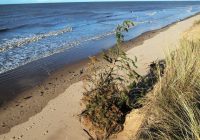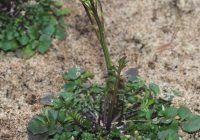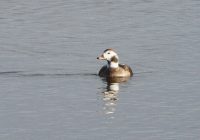Dr Phil Smith’s Wildlife Notes
February 2014
Another extremely mild month with virtually no frosts produced significant rainfall on 20 days but nothing remotely like the deluges that caused widespread flooding in the south and south-west of England. By the end of February the sand-dune water-table was still at least 50cm below last year’s record high, Devil’s Hole having shallow flooding only in its deeper sections. A near-hurricane on 12th brought down a few trees locally but our pinewoods are used to winter blows and the following day I found only one Corsican Pine knocked over in the Ravenmeols plantation. This gale brought the Great Northern Diver back onto Southport Marine Lake, where it was joined briefly by a Guillemot. Similarly stormy conditions a few days earlier packed about 4200 Black-tailed Godwits onto the flooded fields at Marshside. One or two Great White Egrets were regularly reported roosting over-night with Little Egrets on one of the Marine Lake islands and I had an excellent view of a Great White at Marshside on 14th.
The big 10.2m tide at the start of the month took a bit more off Formby Point, while, at Hightown, I found Marram rhizomes protruding from the beach about 21m out from the low cliffed sand-dunes opposite the Rifle Range. This shows how much of the dunes here have gone since last summer. According to measurements by Sefton’s Flood and Coastal Erosion Risk Management Team, Formby Golf Course frontage lost nearly 20m during the winter storms, my visit on 4th finding that the first pine-tree in the frontal woodlands had just fallen onto the beach. These plantations will soon go the way of Gypsy Wood which famously disappeared into the sea in the 1980s.
The unseasonably warm temperatures resulted in lots of plants flowering early. At Queen’s Jubilee Nature Trail on 5th, Hairy Bitter-cress was not entirely unexpected but Smooth Sow-thistle in flower was a real surprise. Before the end of the month, in addition to the usual Snowdrops, I found lots more flowering garden bulbs at Kenilworth Road dunes, including Daffodil cultivars, Grape-hyacinth and three different kinds of Crocus – Early, Spring and Yellow. A Drone-fly (Eristalis) was nectaring on one of the Grape-hyacinths. Nearby, starry blue flowers of Greater Periwinkle contrasted with the yellowing grasses. Meanwhile, at Marshside, Colt’s-foot was flowering near spectacular white sprays of Blackthorn.
In my January notes, I described the damage to dunes and slacks at Ravenmeols and Birkdale caused by off-road vehicles. At last, some of the culprits were caught by the police and Sefton Rangers on 22nd when a Landrover Discovery was found bogged down on the Velvet Trail at Birkdale. A second vehicle arrived to pull it out; both were seized by police and an arrest made. It is hoped that this will put a stop to this activity but a great deal of damage has been done and it remains to be seen how well the flora and fauna will recover.
Amphibian & Reptile Conservation organised a group of about 30 volunteers, many of them students from the University of Bangor, to remove scrub at Queen’s Jubilee Nature Trail and the “School Bank” at Kenilworth Road, Ainsdale. This work was designed to improve habitat for Sand Lizards and Natterjack Toads. While working out the areas to be cleared on 21st, I was delighted to see an adult Little Gullflying overhead, this being arguably my favourite bird.
As usual, bird migration began during February with the first Avocet at Martin Mere on 9th, increasing to around 60 by the month’s end. They were slower to arrive at Marshside but I counted four there on 28th when last year’s Long-tailed Duck was still entertaining visitors.
A singing Siberian Chiffchaff attracted birders to Martin Mere in the last few days of the month. This grey eastern sub-species of our familiar woodland warbler is infrequently seen in Britain, the Birds of Lancashire & North Merseyside (2008) stating that although several have been claimed, there is no clear evidence that this race has ever occurred in our region.




